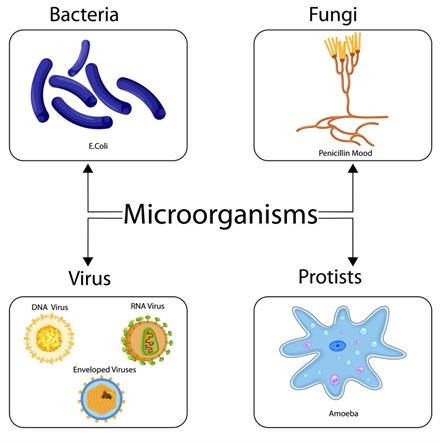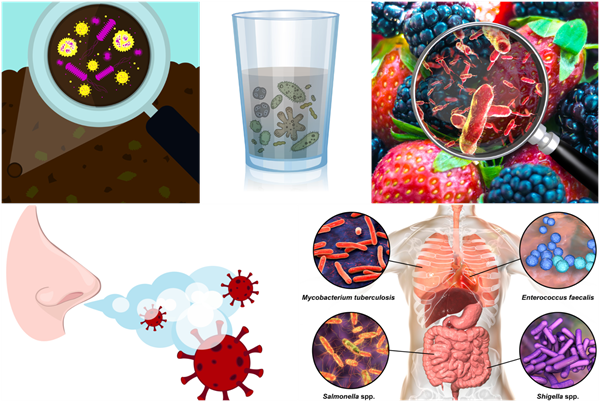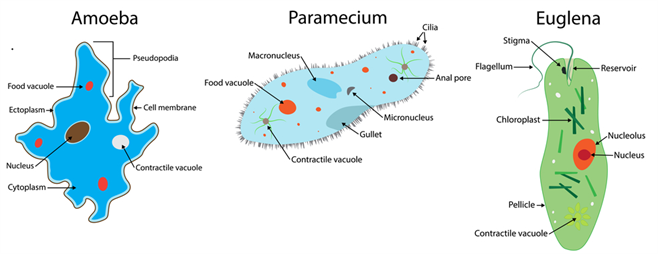PDF chapter test TRY NOW
What happens if you leave a broken coconut out in the open for a week? It will deteriorate. You may have noticed that there are greyish white patches over the white of the coconut. When you look at these patches with a magnifying glass, you will notice tiny black rounded structures. These are fungi, which are a type of microorganism. These are referred to as microorganisms because they cannot be seen with our naked eye. Some microorganisms are only seen through a microscope.
Microorganisms
Important terminologies:
- A single-cell organism that cannot be seen by the naked eye and can only be seen through the microscope is called a microorganism.
- The study of microbes is called microbiology.
- A scientist who studies microorganisms is called microbiologist.
Definition of microbiology:
Microbiology (Greek words: mikros - small, bios- life-bearing, logy- study) is a branch of biology that deals with living organisms of microscopic size, including bacteria, fungi, algae, protozoa and viruses, collectively known as 'microbes'.

Types of microorganisms
Where can we find microbes?
Microbes are ubiquitous and extremophiles, present everywhere, even under extreme conditions, where no other life-form could exist. Microbes are found inside animal's bodies (including humans), air, water, soil, food, etc.

Microbes are present in soil, water, fruits, air and humans
What types of conditions and environment do microbes live in?
Microbes are present in habitats such as terrestrial, aquatic, atmospheric or in living hosts. They can survive under different climatic environments, ranging from ice cold climate to hot springs, water bodies with the high salt condition and low oxygen, dry places with limited water availability, and deserts to marshy, muddy lands.
- Psychrophilic bacteria are defined as cold-loving bacteria,
Example:
Halomonas, Pseudomonas, Hyphomonas
- Thermophiles are called heat-loving microbes.
Example:
Thermus aquaticus and Thermococcus litoralis
In what way microbes are beneficial to us?
Some of the microorganisms are beneficial for human beings.
- Lactobacillus bacteria grow in milk to convert milk into curd.
- Rhizobium is a soil bacteria present in pulse plants' roots and helps fix nitrogen from the air and supply nitrogen compounds to the pulse plants.
- Microorganisms are also used in winemaking, baking, pickling, and other food-making processes.
- Bio fertilisers are organisms that enrich the quality of the soil. Microorganisms like bacteria, fungi and cyanobacteria act as biofertilisers.
- Penicillin is the first antibiotic derived by Alexander Fleming from Penicillium notatum, a type of fungi, which is used to treat infectious diseases caused by microbes.
- Microbes are also used to produce vitamins, organic acids, alcohols and enzymes.
- Microbes can also be used to destroy harmful pests, a process called biocontrol.
- Saccharomyces cerevisiae (yeast) is a single-cell organism used to produce ethanol.
- Sewage (wastewater) is treated by activated sludge formation with microbe's help, thus recycling water.
How are microbes harmful to us?
The majority of the microbes cause severe infections and diseases to plants and animals, including human beings.
Disease-causing microbes are called as pathogens.
Diseases caused by microbes include polio, plague, cholera, tuberculosis, mumps, rabies, malaria etc.
Harmful microorganisms damage not only the human body but also the food we eat. Sometimes, they multiply on food and release toxic products, causing food poisoning.
Symptoms caused by microorganisms:
When the pathogenic organism affects us, we could find some signs such as body ache, fever, cold, diarrhoea, vomiting and many other conditions. These are all related to diseases that affect our health and make us feel uncomfortable.
Categorise of microorganisms:
Microorganisms vary from one another according to their:
i) Size
ii) Morphology
iii) Habitat
iv) Metabolism
v) Composition
vi) Locomotion
vii) Mode of reproduction
Microbes are
- Unicellular (Bacteria as Escherichia coli and protozoa like Entamoeba coli)
- Multicellular (Algae and Fungi)
- Acellular (not composed of cells-Virus)
Microbes include bacteria, viruses, fungi, microscopic algae and protists.
Unicellular organism:
Organisms consist of a single cell, meaning all life processes such as reproduction, feeding, digestion, and excretion occur in one cell. E.g. Bacteria.

Left to right: Amoeba, Paramecium and Euglena
Multicellular organisms:
They are composed of more than one cell as compared to unicellular organisms. Almost all species of animals, plants and most of the fungi are multicellular. E.g. Molds.

Left to right: Fungi and algae
Antonie Van Leeuwenhoek, the first microbiologist designed his own microscope. In 1674, he took plaque from his own teeth and observed it under the microscope. He was astonished to see many tiny organisms moving around, which was otherwise invisible to naked eyes.
